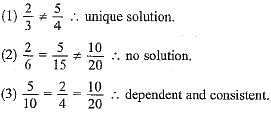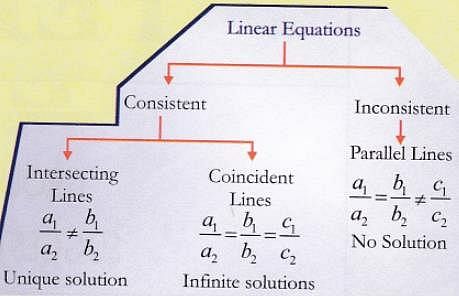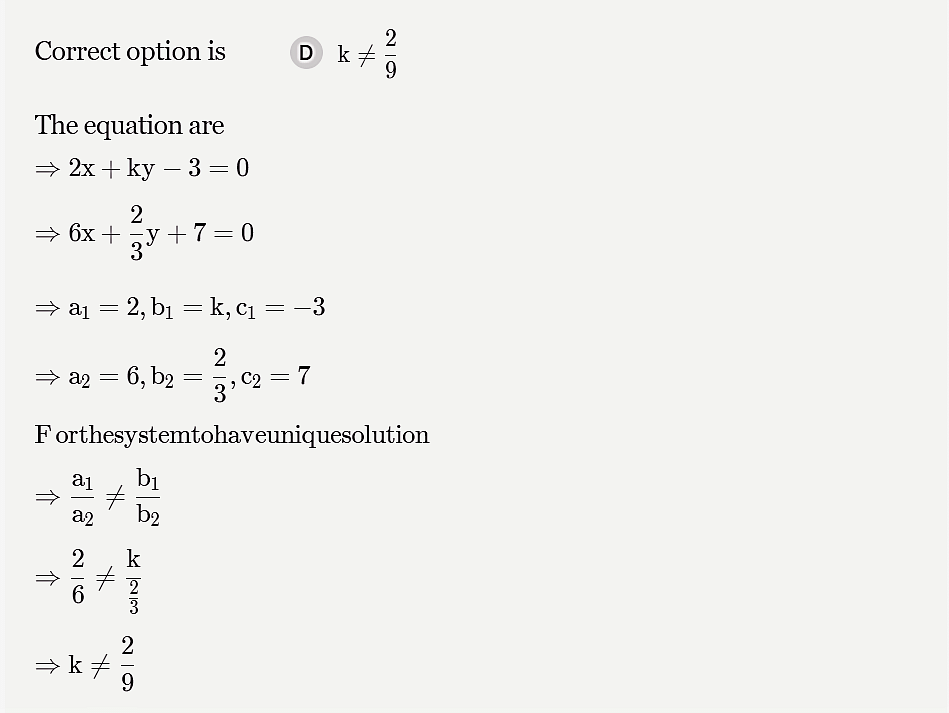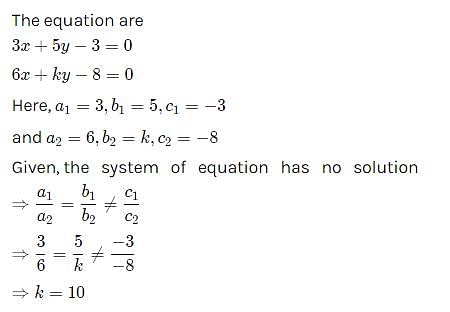All Exams >
SSS 1 >
Mathematics for SSS 1 >
All Questions
All questions of Linear Equations for SSS 1 Exam
For what value of ‘K’ will the system of equations: 3x + y = 1, (2K – 1) x + (K – 1) y = 2K + 1 have no solution- a)3
- b)2
- c)1
- d)-2
Correct answer is option 'B'. Can you explain this answer?
For what value of ‘K’ will the system of equations: 3x + y = 1, (2K – 1) x + (K – 1) y = 2K + 1 have no solution
a)
3
b)
2
c)
1
d)
-2
|
|
Krishna Iyer answered |
 is a case of parallel lines which never meet. So there are no solutions obtainable for these equations. So equations are inconsistent
is a case of parallel lines which never meet. So there are no solutions obtainable for these equations. So equations are inconsistent3x + y = 1, (2K – 1) x + (K – 1) y = 2K + 1
b1=1,b2=k-1,c1=-1,c2=-2k-1


The pair of linear equations 2kx + 5y = 7, 6x – 5y = 11 has a unique solution if –
- a)k ≠ -3
- b)k = 3
- c)k = 5
- d)k = -5
Correct answer is option 'A'. Can you explain this answer?
The pair of linear equations 2kx + 5y = 7, 6x – 5y = 11 has a unique solution if –
a)
k ≠ -3
b)
k = 3
c)
k = 5
d)
k = -5
|
|
Rohit Sharma answered |
Given :
2 k x + 5 y – 7 = 0 ...( i )
6 x – 5 y – 1 = 0 ... ( ii )
Pair of linear equations has a unique solution.
We know for unique solution.
6 x – 5 y – 1 = 0 ... ( ii )
Pair of linear equations has a unique solution.
We know for unique solution.

Comparing from ( i ) and ( ii ) we have

Put these values in formula.

Thus we get answer many values of k but leaving k ≠ -3.
Can you explain the answer of this question below:The sum of the numerator and denominator of a fraction is 18. If the denominator is increased by 2, the fraction reduces to 1/3. The fraction is
- A:
7/11
- B:
-5/13
- C:
-7/11
- D:
5/13
The answer is d.
The sum of the numerator and denominator of a fraction is 18. If the denominator is increased by 2, the fraction reduces to 1/3. The fraction is
7/11
-5/13
-7/11
5/13
|
|
Rahul Kapoor answered |
Let the numer be x & denom be y..
x+y= 18....(1)
x/y+2 =1/3
3x=y+2
x=(y+2)/3
put this value in eq 1
x+y=18
(y+2)/3+y=18
(y+2+3y= 18x3
4y+2 =54
4y=54-2
4y= 52
y= 52/4
y= 13
put the value of y in eq 1
x+y=18
x+ 13=18
x= 18- 13
x= 5
Hence req. fraction = x/ y = 5/13
Can you explain the answer of this question below:The pair of equations y = 0 and y = -7 has :
- A:
no solution
- B:
infinitely many solutions
- C:
one solution
- D:
two solutions
The answer is a.
The pair of equations y = 0 and y = -7 has :
no solution
infinitely many solutions
one solution
two solutions
|
|
Raghav Bansal answered |
y=0 is x-axis… since every point has y=0. y=-7 is a line parallel to x-axis passing through x=0,y=-7. So the two lines are parallel to each other and are inconsistent which means that it has no solutions because it will never meet.
Which of following is not a solution of 3a + b = 12 ?
- a)(3, 3)
- b)(5, -3)
- c)(4, 0)
- d)(2, 4)
Correct answer is option 'D'. Can you explain this answer?
Which of following is not a solution of 3a + b = 12 ?
a)
(3, 3)
b)
(5, -3)
c)
(4, 0)
d)
(2, 4)

|
Prashant Gujjar Pgv answered |
D correct h 3(2)+4=10this is not a solution
The sum of two numbers is 35 and their difference is 13. The numbers are- a)24 and 11
- b)20 and 15
- c)25 and 12
- d)11 and 24
Correct answer is option 'A'. Can you explain this answer?
The sum of two numbers is 35 and their difference is 13. The numbers are
a)
24 and 11
b)
20 and 15
c)
25 and 12
d)
11 and 24

|
Pranav Menon answered |
Let the numbers be x and .y.
According to question, x+y = 35 ………(i) and x−y = 13 ………..(ii)
Adding eq. (i) and (ii), we get 2x = 48 ⇒ x = 24
Putting the value of x in eq. (i), we get 12+y = 35 ⇒ y = 13
Therefore, the numbers are 24 and 13.
According to question, x+y = 35 ………(i) and x−y = 13 ………..(ii)
Adding eq. (i) and (ii), we get 2x = 48 ⇒ x = 24
Putting the value of x in eq. (i), we get 12+y = 35 ⇒ y = 13
Therefore, the numbers are 24 and 13.
The pair of linear equations kx + 4y = 5, 3x + 2y = 5 is consistent only when –- a)k≌6
- b)k = 6
- c)k≌3
- d)k = 3
Correct answer is option 'A'. Can you explain this answer?
The pair of linear equations kx + 4y = 5, 3x + 2y = 5 is consistent only when –
a)
k≌6
b)
k = 6
c)
k≌3
d)
k = 3
|
|
Aditya Shah answered |
kx + 4y = 5, 3x + 2y = 5
Here, a1=k,b1=4,c1=−5
and a2=3,b2=2,c2=-5

So , The equation is consistent when

k ≠ 6
Here, a1=k,b1=4,c1=−5
and a2=3,b2=2,c2=-5

So , The equation is consistent when


k ≠ 6
If x + 2y = 5 & x – 2y = 7, then the value of x & y is: -- a)x = 6 & y = 3
- b)x = 12 & y = -1/2
- c)x = 6 & y = -1/2
- d)None of the above
Correct answer is option 'C'. Can you explain this answer?
If x + 2y = 5 & x – 2y = 7, then the value of x & y is: -
a)
x = 6 & y = 3
b)
x = 12 & y = -1/2
c)
x = 6 & y = -1/2
d)
None of the above
|
|
Roshni jain answered |
Solution:
Given, x + 2y = 5 ...(1)
and x + 2y = 7 ...(2)
Subtracting Equation (1) from Equation (2), we get
( x + 2y ) - ( x + 2y ) = 7 - 5
⇒ 0 = 2
The above equation is not satisfied for any value of x and y. Therefore, such values of x and y do not exist.
Hence, the correct option is (d) None of the above.
Given, x + 2y = 5 ...(1)
and x + 2y = 7 ...(2)
Subtracting Equation (1) from Equation (2), we get
( x + 2y ) - ( x + 2y ) = 7 - 5
⇒ 0 = 2
The above equation is not satisfied for any value of x and y. Therefore, such values of x and y do not exist.
Hence, the correct option is (d) None of the above.
Find the solution to the following system of linear equations: 2x-y+6=0 4x+5y-16=0- a)(2,-3)
- b)(-1,4)
- c)(2,3)
- d)(1,4)
Correct answer is option 'B'. Can you explain this answer?
Find the solution to the following system of linear equations: 2x-y+6=0 4x+5y-16=0
a)
(2,-3)
b)
(-1,4)
c)
(2,3)
d)
(1,4)
|
|
Pooja Shah answered |
2x-y+6=0
y=2x+6 ….(1)
4x+5y-16=0
Substituting the values
4x+5(2x+6)-16=0
14x+14=0
x=-1
y=4
y=2x+6 ….(1)
4x+5y-16=0
Substituting the values
4x+5(2x+6)-16=0
14x+14=0
x=-1
y=4
If the sum of the ages of a father and his son in years is 65 and twice the difference of their ages in years is 50, then the age of the father is –- a)45 years
- b)40 years
- c)50 years
- d)55 years
Correct answer is option 'A'. Can you explain this answer?
If the sum of the ages of a father and his son in years is 65 and twice the difference of their ages in years is 50, then the age of the father is –
a)
45 years
b)
40 years
c)
50 years
d)
55 years
|
|
Kuldeep Kuldeep answered |

Learn how to form quadratic equations and how to solve them by going through this document of important definitions and formulas for quadratic equations:
https://p1.edurev.in/studytube/Important-definitions-and-formulas-Quadratic-Equat/b324db73-b4c1-42a0-9b27-228a123e101b_t
Which of the following pair of linear equations is inconsistent?- a)5x – 3y = 11; 7x + 2y =13
- b)x – 2y = 6; 2x + 3y = 4
- c)9x – 8y = 17; 18x -16y = 34
- d)2x + 3y = 7; 4x + 6y = 5
Correct answer is option 'D'. Can you explain this answer?
Which of the following pair of linear equations is inconsistent?
a)
5x – 3y = 11; 7x + 2y =13
b)
x – 2y = 6; 2x + 3y = 4
c)
9x – 8y = 17; 18x -16y = 34
d)
2x + 3y = 7; 4x + 6y = 5
|
|
Krishna Iyer answered |
Pair of linear equations are inconsistent when they are parallel. When the two equations are parallel ,we have  .
.
 .
.In D, we have  which is
which is  , so it is inconsistent.
, so it is inconsistent.
 which is
which is  , so it is inconsistent.
, so it is inconsistent.If x = a, y = b is the solution of the equations x – y = 2 and x + y = 4, then the values of a and b are, respectively.- a)3 and 1
- b)-1 and -3
- c)3 and 5
- d)5 and 3
Correct answer is option 'A'. Can you explain this answer?
If x = a, y = b is the solution of the equations x – y = 2 and x + y = 4, then the values of a and b are, respectively.
a)
3 and 1
b)
-1 and -3
c)
3 and 5
d)
5 and 3
|
|
Arun Yadav answered |
Since, x = a and y = b is the solution of the equations x – y = 2 and x+ y = 4, then these values will satisfy that equations
a-b= 2 ,..(i)
and a + b = 4 … (ii)
On adding Eqs. (i) and (ii), we get
2a = 6
a = 3 and b = 1
The pair of linear equations 8x – 5y = 7 and 5x – 8y = -7 have :- a)No solution
- b)Many solutions
- c)One solution
- d)Two solutions
Correct answer is option 'C'. Can you explain this answer?
The pair of linear equations 8x – 5y = 7 and 5x – 8y = -7 have :
a)
No solution
b)
Many solutions
c)
One solution
d)
Two solutions
|
|
Raghav Bansal answered |
 So, they are intersecting lines. And intersecting lines meet at only one point. So only 1 solution is available.
So, they are intersecting lines. And intersecting lines meet at only one point. So only 1 solution is available.Which of the following pairs of equations represent inconsistent system?- a)3x – y = -8 3x – y = 24
- b)5x – y = 10 10x – 2y = 20
- c)3x – 2y = 8 2x + 3y = 1
- d)lx – y = m x + my = l
Correct answer is option 'A'. Can you explain this answer?
Which of the following pairs of equations represent inconsistent system?
a)
3x – y = -8 3x – y = 24
b)
5x – y = 10 10x – 2y = 20
c)
3x – 2y = 8 2x + 3y = 1
d)
lx – y = m x + my = l
|
|
Amit Sharma answered |
 is a case of parallel lines which never meet. So there are no solutions obtainable for these equations. So equations are inconsistent.
is a case of parallel lines which never meet. So there are no solutions obtainable for these equations. So equations are inconsistent.3x – y = -8 ,3x – y = 24
3x – y +8=0 ,3x – y -24=0

So,
 Therefore the equations are inconsistent.
Therefore the equations are inconsistent.Chapter doubts & questions for Linear Equations - Mathematics for SSS 1 2024 is part of SSS 1 exam preparation. The chapters have been prepared according to the SSS 1 exam syllabus. The Chapter doubts & questions, notes, tests & MCQs are made for SSS 1 2024 Exam. Find important definitions, questions, notes, meanings, examples, exercises, MCQs and online tests here.
Chapter doubts & questions of Linear Equations - Mathematics for SSS 1 in English & Hindi are available as part of SSS 1 exam.
Download more important topics, notes, lectures and mock test series for SSS 1 Exam by signing up for free.
Mathematics for SSS 1
59 videos|244 docs|72 tests
|
Signup to see your scores go up within 7 days!
Study with 1000+ FREE Docs, Videos & Tests
10M+ students study on EduRev













 So,
So, a1a2=b1b2c1c2which is a case of parallel lines which which never meet. So there are no solutions obtainable for these equations.
a1a2=b1b2c1c2which is a case of parallel lines which which never meet. So there are no solutions obtainable for these equations.
 which is satisfied by 10x – 14y = -4 only.
which is satisfied by 10x – 14y = -4 only.























